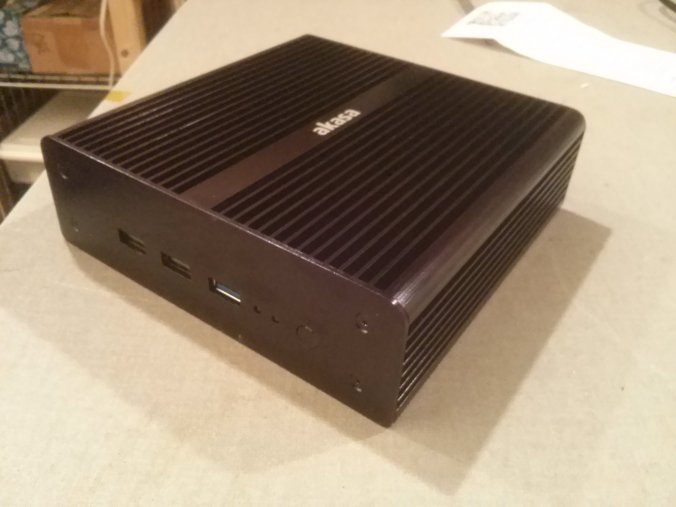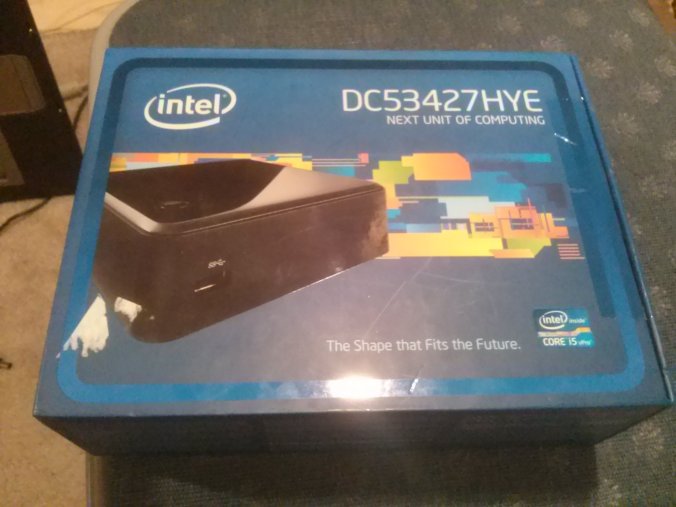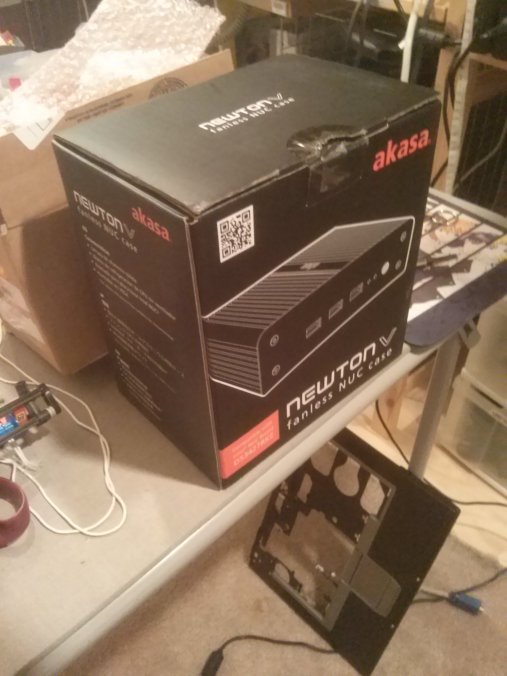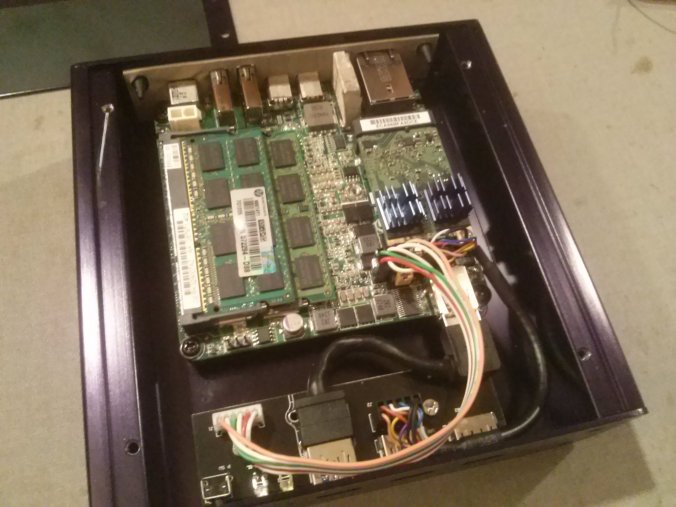I’ve been waiting for this for a really long time, at least since I dabbled with my fanless E6400 so many years ago.

About a year and a half ago, I got my T430 with the intent of using it as a desktop replacement. The idea was that the laptop draws less power, makes less noise, and takes up less space than even an SFF conventional desktop. It also has a built-in UPS (the battery), and you can obviously use it as a laptop in a pinch. This is all fine and dandy, and the T430 has been great so far, but it’s still a stopgap between that SFF conventional desktop and a machine that makes no noise and takes up even less space than a 14″ laptop and dock. Such a machine wasn’t really a practical option when I bought the T430… but it is now!
Enter the Intel NUC. NUC is a mediocre acronym for “Next Unit of Computing”, but it’s about making a really small full-featured desktop by leveraging mobile parts like ULV CPUs, SODIMM memory, mSATA SSDs, etc. Ultimately this means that the dimensions of the stock chassis are about 5″ x 5″ x 2″, which may not be that much smaller than a small laptop by volume, but it’s a huge reduction in footprint, especially compared to a that 14″ laptop and dock. The first NUC was released in Q1 2013 (basically right after I got the T430), and it featured a Sandy Bridge Celeron, so it wasn’t that exciting. In the last year, the NUC lineup has expanded to more than 10 SKUs with Ivy, Haswell, and even Bay Trail NUCs with a limited variety of ports and features.
Intel making NUCs was a necessary but insufficient condition for my fanless USSF, since the stock NUC still has a fan. It was only within the last 9 to 6 months, as the NUC started to gain some traction, that third parties began to make fanless NUC cases.

(when you open the box it makes that Intel sound!)
The NUC that I decided on getting is the horribly named* DC53427HYE, which features an Ivy Bridge LV Core i5, HD 4000 graphics, and probably the most ports out of all the NUC SKUs. That that bit is why I chose this particular NUC: I wanted at least one USB 3.0 port (that eliminates the three earlier SKUs), and two identical display outputs (having two different adapters for two screens bothers my OCD, and this eliminates all the other NUC SKUs except the DC53427HYE). It also comes with the stock case, a VESA bracket, and a power supply; Intel sells the motherboard by itself as the DC53427RKE, but it’s just as expensive as the full kit, and this is retarded because I don’t need that other stuff.

The passive case that I got is the Akasa Newton V, which is the smallest and cheapest such case that fits the DC53427HYE.
I’ve had this project in mind for a while now – I was even considering waiting for the Broadwell NUCs, which were rumored to also fit my above criteria – but I finally decided to get the DC53427HYE when I saw it at Fry’s for just $300, which was about $100 less than I’d seen it anywhere else, including online. It may have been my lucky day as it was also the last one, and the associate I spoke to said that they weren’t getting anymore. So I bought that, ordered some of the other tidbits I’d need, and waited for everything to show up.

Putting it all together was pretty simple, way less involved than building a conventional desktop, and that is already pretty simple these days. The fanless E6400 could get pretty hot under sustained load, and that had been and was a concern then and now, so the first thing I did after installing Windows was run some burn-in tests. Full CPU load temps were about 80C, and full CPU and GPU load temps were a little higher. The chassis also got pretty hot to touch at that point, and the orientation does make a difference: standing it on an edge lets it dissipate heat better than resting it on its stomach.
Nonetheless, there was nothing too concerning except that the SSD temps went into the 90s, which really surprised me. I was concerned about this because the operating temps are supposed to be 0C to 70C, and last I checked 90C > 70C. I had to sit on this for a while; I considered things like replacing the bottom cover with some metal mesh, but eventually I just put tiny heatsinks (I had these leftover from a passive GPU cooler – you can see them in the photo above: they are blue) on the SSD, which dropped the full load temps into the low 70s. It’s still a tiny bit worrisome, but full CPU and GPU load is something that really shouldn’t happen in normal operation.

So in the end, I sat on it for a bit more, deciding on whether or not I should care about the temps, but I decided to not care and set up the NUC, after which I rearranged my setup and got a lot of space back on the desk and the shelves next to the desk. Yay!
An aside on performance:
I usually say that specs are more or less irrelevant to me, but I’d like to put it in perspective:
| Machine | Year | CPU | Place | wPrime 32 | GPU | Place | 3DMark 03 |
|---|---|---|---|---|---|---|---|
| Inspiron 500m | 2003 | Pentium M 1300 | 711/852 | ~120s | Intel Extreme Graphics 2 | 579/591 | 115.5 |
| Latitude D830 | 2007 | Core 2 Duo T7300 | 325/852 | ~38s | Nvidia Quadro NVS140M | 426/591 | 5242 |
| Latitude E6400 | 2009 | Core 2 Duo SU9300 | 551/852 | ~59s | Intel Graphics Media Accelerator (GMA) 4500MHD | 484/591 | 1894 |
| Motoko | 2009 | Pentium Dual Core E2410 @ 2.66GHz | ~250/852 | ~36s | Nvidia GeForce 9500 GT | ~300/591 | ~14000 |
| ThinkPad x220 | 2011 | Core i5 2410m | 125/852 | 19.1s | Intel HD Graphics 3000 | 379/591 | 7751 |
| DC53427HYE | 2013 | Core i5 3427U | 131/852 | 19.85s | Intel HD Graphics 4000 | 294/591 | 12768 |
This is a table of some of the laptops (and desktop) I’ve owned over the past couple years. Some of these fields are self explanatory. wPrime 32 is a simple multi-threaded CPU benchmark (lower is better), and 3DMark 03 is a simple gaming benchmark (higher is better). The CPU “place” is the CPU’s rank on the awesome Notebookcheck Mobile CPU benchmark list, and the GPU “place” is the GPU’s rank on the also awesome Notebookcheck Mobile GPU benchmark list. The numbers with tildas are my estimates for gaps in the benchmark lists – the really rough ones are the ones for Motoko because these are mobile benchmark lists.
Around 2007 is the heyday of Windows XP, and about the time “normal” computing workloads more or less flatlined. The D830 represents a pretty standard laptop from that time with a mid-range CPU and a low-end dGPU. The low-end stuff we are getting now in the form of the 3427U and HD 4000 (integrated graphics) is basically twice as fast and consumes half as much power if not less. Nonetheless, you’ll notice that the relative performance of CPUs has increased much faster than that of GPUs. Motoko represents a low-end/mid-range desktop from 2008, and the DC3427HYE is almost twice as fast on the CPU front, but only barely as fast on the GPU front.
A 3DMark 03 score of about 6000 is about where you’d need to be to comfortably (continuous 30fps) play Starcraft II at the lowest settings.
The gains on the SSD front are also notable, if not even more interesting. These costs and CrystalDiskMark numbers come from previous posts and my own experience/tests:
| Drive | Year | Price | Sequential Read | Sequential Write | Random Read 512K | Random Write 512K | Random Read 4K | Random Write 4k |
|---|---|---|---|---|---|---|---|---|
| Toshiba MK8052GSX 80GB | 2008 | $40 | 51.705 MB/s | 51.001 MB/s | 22.201 MB/s | 25.963 MB/s | 0.297 MB/s | 0.948 MB/s |
| Samsung MCCOE64G5MPP (RBX SLC) 64GB | 2008 | $500 | 94.794 MB/s | 86.774 MB/s | 92.378 MB/s | 68.579 MB/s | 15.583 MB/s | 5.387 MB/s |
| Intel X25-M G1/G2 80GB | 2009 | $230 | 241 MB/s | 79 MB/s | 183 MB/s | 71 MB/s | 14 MB/s | 14 MB/s |
| Samsung 830 mSATA 128GB | 2012 | $120 | 456 MB/s | 257 MB/s | 315 MB/s | 178 MB/s | 20 MB/s | 43 MB/s |
Quite frankly, I can hardly tell the different between the Samsung RBX and the Intel G1/G2, and certainly not between the Intel G1/G2 and the Samsung 830 (this is in the NUC; I think J has an 830 too). Nonetheless, between 2008 and 2012 the general MSRP on good SSDs dropped by an order of magnitude ($10 per GB to $1 per GB, and it’s halved again to $0.5 per GB on some big drives since then), and the speeds have increased by maybe half an order of magnitude. This is on top of being 2 to 10 times faster than conventional HDDs, and this is huge compared to the gains in CPU and GPU performance. I said this 4 years ago, but it’s way more pertinent now: nobody should be using conventional hard drive for anything other than storage in this day and age.
* I say that DC53427HYE is a bad name, but at least it’s very specific, and can only refer to this product. What I hate much more are some of the Apple style names like “Macbook Pro 13” that can refer to Macbook Pro 13s of several generations because they are all called Macbook Pro 13. It used to just be Apple doing this, but now other OEMs are picking it up, and it is getting more and more annoying.